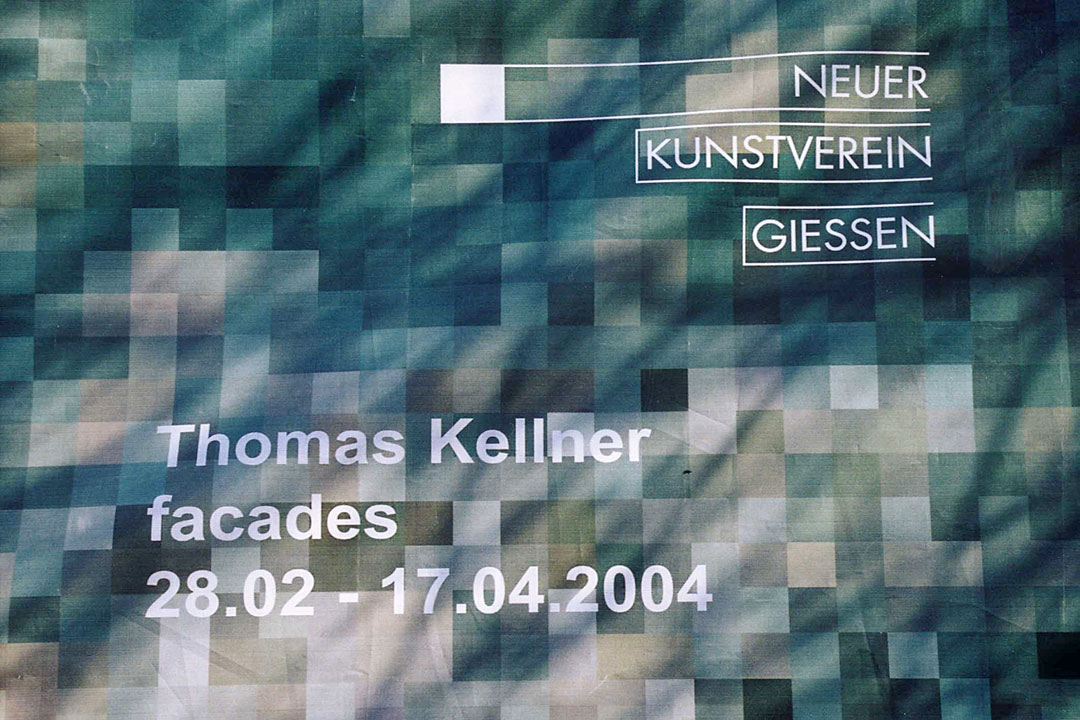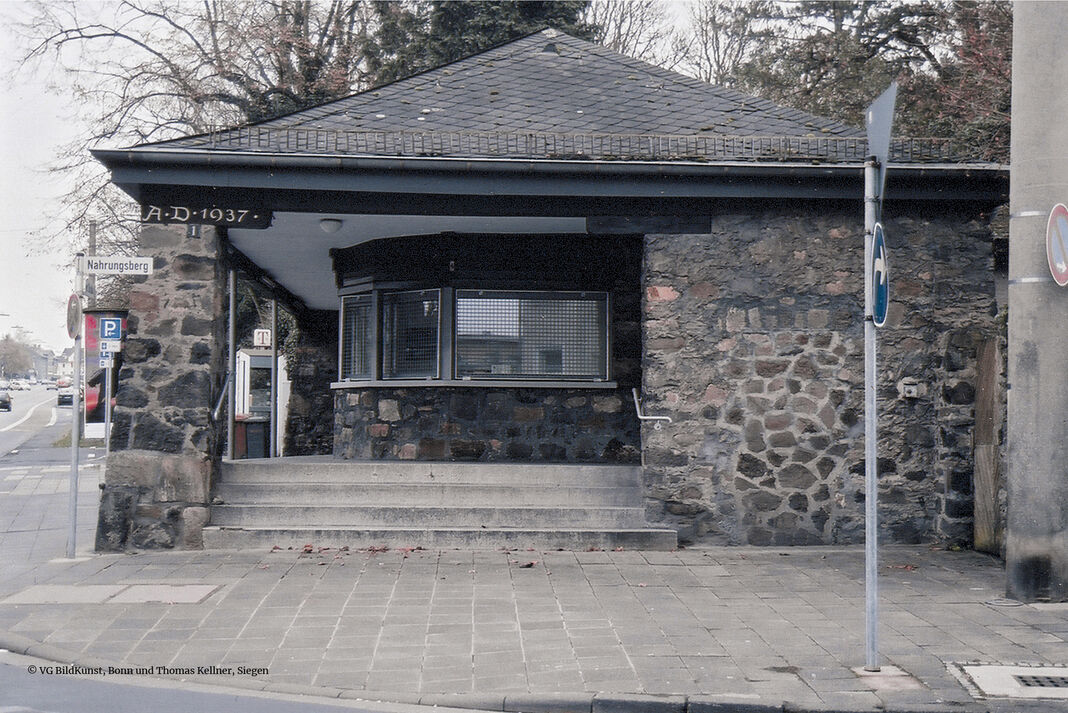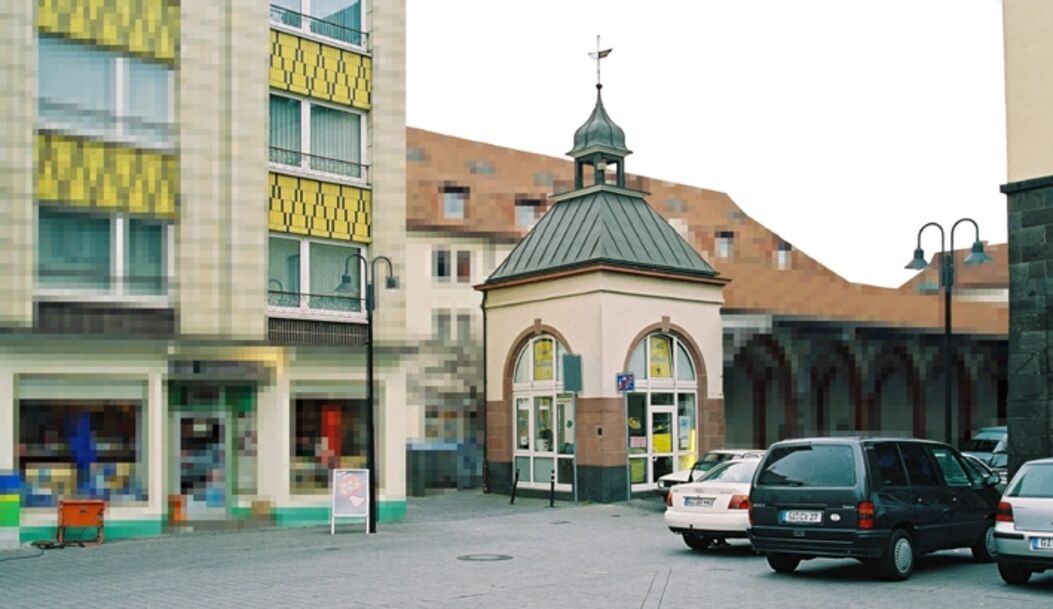Facades Artworks Interfering in the Cityscape
Neuer Kunstverein Giessen
Thomas Kellner: façades
28. February - 17. April 2004
The „Neuer Kunstverein Giessen“ presents new artworks by Thomas Kellner.
Thomas Kellner, visiting professor at the Justus-Liebig-University in 2003/4, got internationaly known with his photographic collages of architectures. Again he dedicates a new project to urbanism and its perception.
Thomas Kellner wrapes the facades of the exhibition building with a veil of pixels . He covers the building with a reduced pictures of its self. On one hand he dematerializes the building and on the other hand he carries our second, parallel world of the digitala era into our immediate reality. He builds with pixels, like with bricks a new appearance to the building.
Like his other projects Kellner irritates the spectator in his perception. From a distance only the dimensions of the building may appear curious, but getting closer, the facades remove from their real visual identity. The façade becomes a picture, becomes pixels and the building seems to loose itself in cyberspace. Parts of the building, like the roof, or in other scetches balconies, remain real, are not covered. Picture and building, pixel and reality seem to exist at the same time in one place.
NEUER KUNSTVEREIN GIESSEN e.V.
Ecke Licher Straße/Nahrungsberg


"Thomas Kellners artistic concept is composed of well-worn perceptions to irritate with many differents photographic means and to show the disposition." Dr. Gerd Steinmüller, February, 28th 2004
Installation of Facades at Max hat's









Facades Artworks












Facades in an urban space
Exploring Digital Architecture: Facades are Vision for "Max hat's"
If one wants to describe Thomas Kellner's artistic concept in a few words, one could say that he is always concerned with irritating and disposing of entrenched modes of perception with very different photographic means. How this concept was supposed to work in the context of "Max hat's" was still an absolute mystery to me just under a year ago, when we were standing here talking about it for the first time. At that time, Thomas Kellner, who had just been appointed "Visiting Professor of Art" at the Institute for Art Education at the University of Giessen, spoke of digitized architecture, of dissolution and disintegration into pixels, similar to television, when people are deliberately made unrecognizable. It was not easy for me to make sense of this in view of the then still rather desolate condition of this exhibition site. But it wasn't easy either, because until then I had rather assumed that Thomas Kellner was a representative of low tech photography, who consciously refrained from too much technical effort in order to keep as many design options open as possible.
Eliciting Stillness and Melancholy: Hubertus von Amelunxen's Observations
I met Thomas Kellner, who was born in Bonn in 1966, in 1992 at the University of Siegen. There he was a student of art and social sciences for the teaching profession at secondary schools, but he was actually already an obsessed photographer who converted almost everything that could accommodate light-sensitive objects into pinhole cameras, from small boxes and cans to garbage cans and trucks. If such containers proved to be completely incompatible with his photographic ideas, he simply designed and built new devices, such as those with several holes, or the camera with which Thomas Kellner traveled 6,000 km along the German border to document each border crossing individually. For this 1996 project, called "Germany. Blick nach draußen," which was also his state thesis, The artist not only received an excellent exam grade, but also the Kodak Young Talent Award. In the catalog for this project, Hubertus von Amelunxen remarked:
"Thus Kellner's survey of German borders conveys itself to the viewer in a peculiar stillness, somewhat melancholy this freedom puts us in the mood. The images seem to widen the space and yet in the process take the ground from under our feet." (p. 16)
"Taking the ground from under our feet," as von Amelunxen said, was soon to define Thomas Kellner's work in a very different way. Since 1997, with the beginning of his work as a freelance artistic photographer, he again explored the possibilities of conventional, or more precisely: analog commercially available cameras. The result was the project "Monuments", in which the artist dissects architectural, preferably urban landmarks such as the Eiffel Tower, the Berlin Memorial Church, Big Ben, Tower Bridge, the Alhambra, etc. into a plethora of individual images, in order to then reassemble these fragments in an amazingly new way.
Significance in the Aftermath: Art and the Impact of 9/11
This deconstructive-reconstructive process, which gives the all too often photographed, the visually worn and thus also the all too often overlooked, a completely different presence, gained unexpected topicality through the attack on the landmark of New York, the Twin Towers of the World Trade Center, on September 11, 2001. Especially in the USA, the artist's photographic works have since received growing attention and recognition. Solo exhibitions took place in Winchester, New York and Chicago in 2002 and 2003. Purchases of his work have also been made by renowned public collections, such as the Museum of Fine Arts in Houston and the Art Institute of Chicago. Of Kellner's architectural collages, Alan C. Artner noted in the Chicago Tribune, "Who would have thought that so much wonder could still be created with straight photographs in a time given to digital manipulation?"
Dematerialization and Materialization: Paradoxical Qualities of his Art
Thomas Kellner's latest project "facades" shows that he is by no means afraid or reserved about digital photography and the possibility of manipulating images without limits, but on the contrary knows how to appropriate this medium from an intensive artistic examination. He developed this project during his time as a visiting professor at the Justus Liebig University in Giessen. The starting point - as his project book illustrates with the designs - is a series of buildings in Giessen, whose facades are each clad with a reduced, highly pixelated image of themselves or are to be imagined as clad. Put into practice and executed on a scale of 1 : 1, the result is a very strange effect: Seen from a distance, the architecture still appears to be largely intact and only slightly displaced in itself. As one approaches the building, however, its façade appears to be increasingly dissolving. Architecture now suddenly transforms into an image, with the image being reduced more and more to its basic components, to individual pixels. Or to put it another way: the material appears dematerialized. Paradoxically, however, what is immaterial in and of itself can nevertheless take on material qualities. Because of their size and because they are always perceived in the context of unveiled architectural components, the roof or, in other designs, balconies, the individual pixels do not so much appear as the end products of a process of decay, but rather as starting materials, as building blocks, so to speak, from which a virtual parallel world is formed that now confronts the real, actually existing world on an equal footing and appears to be built into it, as it were.
Power in Perception: The Ability to Captivate and Intrigue with facades
This subtle play with perception, which has been at the center of his artistic conception since his early pinhole camera projects, shows here the coexistence of architecture and image, of reality and virtuality in natura. Thomas Kellner has really succeeded in giving "Max hat's", the secret landmark of Gießen, a powerful artistic exclamation mark and making it an exciting eye-catcher.
( Dr. Gerd Steinmüller, February 28, 2004 )








